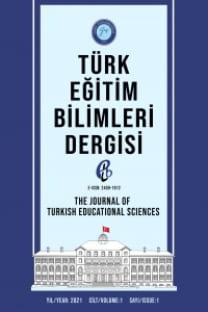İLKÖĞRETİM ÖĞRETMEN ADAYLARININ TEKNOLOJİYE YÖNELİK TUTUMLARININ KÜMELEME ANALİZİ
Günümüzde teknolojiyi kullanmak bir ayrıcalık değil, zorunluluk olmuştur. Teknolojik gelişmeler eğitim kurumlarının yapı ve işlevlerini etkilemektedir. Bu nedenle öğretmenlerin de bilgi toplumu bireyleri yetiştirebilmeleri için derslerini teknoloji ile bütünleştirmeleri beklenmektedir. Bu çalışmada, öğretmen adaylarının teknolojiye yönelik tutumlarının kümelenme eğilimleri belirlenmeye çalışılmıştır. Araştırmaya Dicle Üniversitesi Siirt Eğitim Fakültesi İlköğretim Fen Bilgisi, Matematik ve Sınıf Öğretmenliği programlarında okuyan 317 (87 kadın, 230 erkek) öğretmen adayı alınmıştır. Veri toplama aracı olarak Yavuz (2005) tarafından geliştirilen “Teknoloji Tutum Ölçeği” kullanılmıştır. Verilerin çözümlenmesinde aşamalı kümeleme yöntemlerinden Ward’s yöntemi kullanılmış, uzaklık ölçüsü olarak karesel öklid uzaklığı seçilmiştir. Ward’s kümeleme yöntemine göre teknolojiye yönelik tutum değişkenleri olumlu ve olumsuz tutumlar şeklinde iki kümede sınıflandırılmıştır. Olumlu kümeler; gelişen teknolojiyle paralel olarak öğretmenlerde bulunması gereken nitelikler, eğitim ve öğretimde teknolojik araçların kullanımı, eğitim hayatında bilgisayar yazılımlarının kullanımı, teknolojik araç gereçleri kullanma becerisi ve önemine ilişkin tutumları belirtmektedir. Olumsuz kümeler ise; teknolojik araçların eğitimde kullanılmama durumu, teknolojik araçları kullanmanın olumsuz yanları, teknolojik araçları kullanma zorluğuna yönelik tutumları göstermektedir.
Anahtar Kelimeler:
Teknoloji, teknoloji eğitimi, teknoloji tutum ölçeği, kümeleme analizi
THE CLUSTER ANALYSIS OF PRIMARY SCHOOL CANDIDATE TEACHERS’ ATTITUDES TOWARD TECHNOLOGY
Nowadays; the usage of technology is not a privilege but an obligation. Technological developments influence structures and functions of educational institutions. It is also expected from the teachers that they integrate technology in their lessons in order to educate the individuals of information society. This research has covered 317 (87 female, 230 male) students, studying in Siirt Education Faculty of Dicle University; the programmes of primary science, mathematics and school teaching. The Technology Attitude Scale developed by Yavuz (2005) was used as a data collecting tool. For analyzing data, Ward’s method of hierarchical clustering was used and a squared Euclidian distance was chosen as a distance measure. It was determined that with Ward’s cluster analysis, attitude variables are classified into two groups as positive and negative attitudes. Positive clusters include; the necessary characteristics for candidate teachers according to technological developments, the usage of technological tools in teaching and education, the usage of computer literacy in education life, the ability and importance of using technological tools. Negative clusters include; the attitude of non-using technological tools in education, the negative sides of not using technological tools and the difficulties of using technological tools.
___
- Akkoyunlu, B. (2002). Educational technology in Turkey: past, present and future. Educational Media International, 39(2), 165-174.
- Alkan, C. ( 1997). Eğitim teknolojisi. Ankara: Anı Yayıncılık.
- Aşan, A. (2002). Pre-service teachers’ use of technology to create ınsructional materials: A school-college partnership. Technology, Pedagogy and Education, 11(2), 217-232.
- Çepni, S. (2005). Fen ve teknoloji öğretimi. Ankara: Pegem A Yayınları.
- Dahl, T. ve Naes, T. (2004). Outlier and group detection in sensory panels using hierarchical cluster analysis with the procrustes distance. Food Quality and Preference, 15, 195–208.
- He, Q. (1996). A review of clustering algorithms as applied in IR. Graduate School of Library and Information Science University of Illinois at Urbana-Compaign. http://out.uclv.edu.cu/cei/
- Hızal, A. (1989). Bilgisayar eğitimi ve bilgisayar destekli öğretime ilişkin öğretmen görüşlerinin değerlendirilmesi. Eskişehir: Anadolu Üniversitesi Yayınları.
- İşman, A. (2002). Sakarya ili öğretmenlerinin eğitim teknolojileri yönündeki yeterlilikleri. The Turkish Online Journal Of Educational Technology, 1(1).
- Kirschhner, P. ve Selinger, M. (2003). The state of affairs of teacher education with respect to information and communications technology. Technology, Pedagogy and Education, 12(1), 5–17.
- Mucha, H. J. ve Sofyan, H. (2003). Cluster analysis. http://www.mdtech.de
- Özdamar, K. (2002). Paket programları ile istatistiksel veri analizi (çok değişkenli analizler) 2. Eskişehir: Kaan Kitapevi.
- Sala, C. H. ve Bragulat, E. J. (2004). A program to perform Ward’s clustering method on several regionalized variables. Computers & Geosciences, 30, 881–886.
- Şemseddin, G. ve Odabaşı, F. (2004). Bilgi çağında öğretmen adaylarının eğitimde öğretim teknolojileri ve materyal geliştirme dersinin önemi. The Turkish Online Journal of Educational Technology, 3(1).
- Tatlıdil, H. (1996). Uygulamalı çok değişkenli istatistiksel analiz. Ankara: Akademi Matbaası.
- Uçar, M. (1999). İlköğretimde ders araç-gereçleri kullanımı konusunda öğretmen görüşlerinin değerlendirilmesi. Afyon Kocatepe Üniversitesi Sosyal Bilimler Dergisi, (3).
- Yavuz, S. (2005). Developing a technology attitude scale for pre-service chemistry teachers. The Turkish Online Journal of Educational Technology, 4, 1–9.
- Başlangıç: 2003
- Yayıncı: ANKARA HACI BAYRAM VELİ ÜNİVERSİTESİ
Sayıdaki Diğer Makaleler
Araştırıcı sanat eleştirisi yöntemine göre Max Beckmann'ın ''gece'' adlı eserinin analizi
İLKÖĞRETİM II. KADEME ÖĞRENCİLERİNİN FEN BİLGİSİ DERSİNE YÖNELİK TUTUMLARININ BELİRLENMESİ
Nevin KOZCU ÇAKIR, Burcu ŞENLER, Belgin GÖÇMEN TAŞKIN
YAPILANDIRMACI ÖĞRENME ORTAMININ ÖĞRENCİLERİN AKADEMİK BAŞARILARINA VE KALICILIĞINA ETKİSİ
Yapılandırmacı öğrenme ortamının öğrencilerin akademik başarılarına ve kalıcılığına etkisi
ARAŞTIRICI SANAT ELEŞTİRİSİ YÖNTEMİNE GÖRE MAX BECKMANN'IN "GECE" ADLI ESERİNİN ANALİZİ
İLKÖĞRETİM ÖĞRETMEN ADAYLARININ TEKNOLOJİYE YÖNELİK TUTUMLARININ KÜMELEME ANALİZİ
Halil Coşkun ÇELİK, Mustafa KAHYAOĞLU
ARAŞTIRICI SANAT ELEŞTİRİSİ YÖNTEMİNE GÖRE MAX BECKMANN'IN "GECE" ADLI ESERİNİN ANALİZİ
